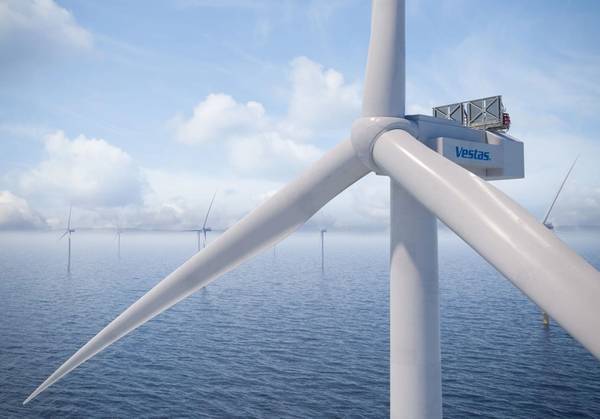
Danish wind turbine manufacturer Vestas has been named as a pre-selected tenderer at EnBW’s 900 MW He Dreiht offshore wind project in the German North Sea.
Depending on a firm and unconditional order eventually being signed, the project will mark the world`s first commercial deployment of the new V236-15.0 MW offshore turbine.
"This means that this highly advanced turbine type has made its mark after only five months on the market," Vestas said.
Vestas was pre-selected through an EU tender process to provide V236-15.0 MW turbines for installation at the project in 2025. The He Dreiht project is located in the German North Sea within 85 km of the island of Borkum and 104 km west of the island of Helgoland.
"With the industry’s largest swept area and a capacity factor of over 60% from the 115.5m blades, the V236-15.0 MW turbine will deliver industry-leading park performance for EnBW at He Dreiht. The swept area of the turbine spans 43,742 m2 and depending on site-specific conditions, a single V236-15.0 MW turbine is capable of producing 80 GWh per year," Vestas said.
"Building on our capabilities as the world leader in sustainable energy solutions, Vestas is resolutely back in offshore wind with our industry-leading V236-15.0 MW turbine, and are delighted to be selected as pre-selected tenderer for He Dreiht by EnBW,” said Henrik Andersen, President & CEO of Vestas. “I must pay tribute to EnBW for the close collaboration over the past several months on finding the right solutions for their He Dreiht project, and we are delighted to begin our partnership in offshore wind off the German coast.”
Nils de Baar, President of Vestas Northern & Central Europe, added: “Germany’s offshore wind ambitions for 20 GW by 2030 will require ground-breaking projects and technology, such as the V236-15.0 MW turbine, to be achieved. Through our regional setup, Vestas is continuously striving to build closer relationships with our customers such as EnBW and provide the right solutions that will enable them to deliver the ambitious projects needed to reach offshore wind targets.”
The He Dreiht project will be operated on a subsidy-free basis by EnBW.
"Turbines are expected to begin being installed in the second quarter of 2025, with full park commissioning anticipated for the fourth quarter of the same year." Vestas said.
In the past year, it has been repeatedly said that in offshore wind, size matters.
Wind turbine manufacturer Siemens Gamesa in May 2020 announced it was working on developing wind turbines with up to 15MW capacity and a 222-meter rotor - the world's largest in the making at the time. The prototype is expected to be ready in 2021, with turbines commercially available sometime in 2024. The giant Siemens Gamesa turbines have already been ordered - conditionally - for projects in Taiwan and the U.S.
GE, the company behind the world's largest wind turbine in operation, Haliade X - the prototype in Rotterdam - which has been spinning since late 2019 - has uprated that same turbine, from 12 MW to 13 MW. The uprated 13MW Haliade-X will continue to feature 107-meter long blades and a 220-meter rotor.
On top of this, GE has also secured a contract to deliver the upscaled Haliade-X 14 MW wind turbines for the Dogger Bank C offshore wind farm in the UK. This will mark the first time these turbines will be installed at any project worldwide.
Energy intelligence group Rystad has explained how bigger wind turbines, while more expensive per unit, decreasethe overall cost of large-scale offshore wind farm projects - up to $100 million compared to using 10MW turbines at 1GW wind farm projects.
"Utilizing 14 MW turbines instead of 10 MW ones, the number of units required for a 1 GW project falls by 28 units, from 100 to 72. Moving to a 14 MW turbine from a 12 MW turbine still offers a reduction of nearly 11 units. Overall, the analysis shows that using the largest turbines for a new 1 GW wind farm offers cost savings of nearly $100 million versus installing the currently available 10 MW turbines," Rystad said in a report.
He Dreiht wind farm
"Ten years ago, offshore wind energy in Germany was still in its infancy. Back then, we built Baltic 1, which was Germany’s first commercial offshore wind farm,” says Dr. Georg Stamatelopoulos, COO Generation at EnBW. “Since then, turbine performance has improved more than six-fold in the space of a decade. We are ready to be writing the next chapter in the history of German offshore wind power with He Dreiht,” Stamatelopoulos added.
EnBW secured the project in Germany’s first offshore tender in 2017.
“Offshore wind power is not only technically challenging. We have to go into the auctions with wind turbines that are not yet on the market at the time of the planning stage. There is no crystal ball here: the only answer is sound technical forecasting and knowledge of the market. And we made the right choices as project developers, as the outcome shows. We are going to use the most advanced and cost-efficient turbine technology, which means we can install He Dreiht without any subsidies,” Stamatelopoulos says.
EnBW He Dreiht will be located in the North Sea, 90 kilometers northwest of Borkum and about 110 kilometers west of Heligoland. It is among the biggest planned offshore wind power projects in Europe and is scheduled to go into operation in 2025. The final investment decision is planned for 2023.



